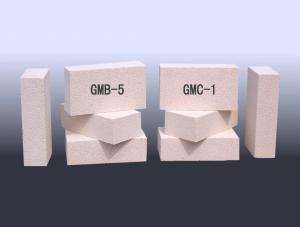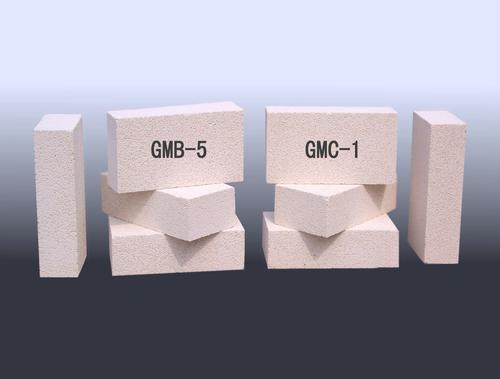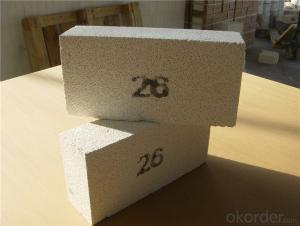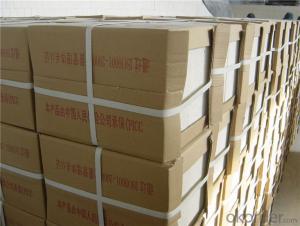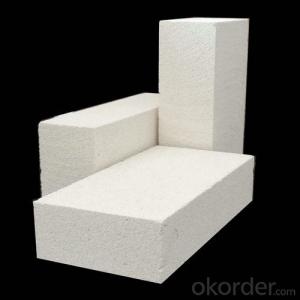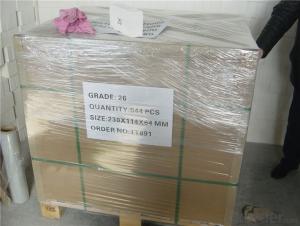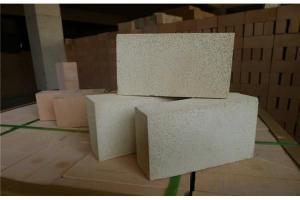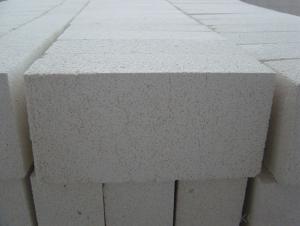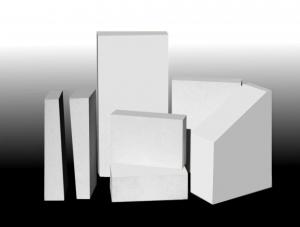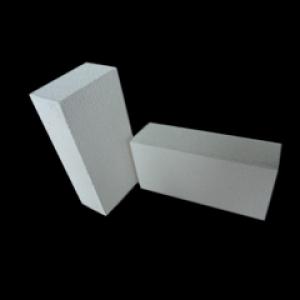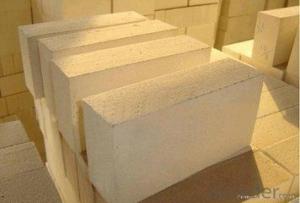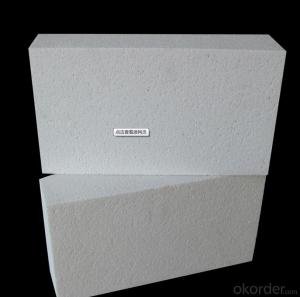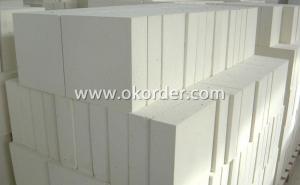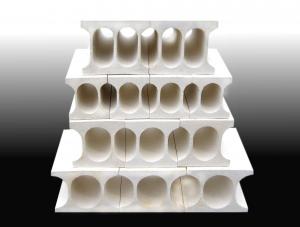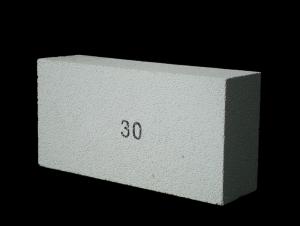Insulating Fire Brick B5
- Loading Port:
- China Main Port
- Payment Terms:
- TT OR LC
- Min Order Qty:
- -
- Supply Capability:
- -
OKorder Service Pledge
Quality Product, Order Online Tracking, Timely Delivery
OKorder Financial Service
Credit Rating, Credit Services, Credit Purchasing
You Might Also Like
General Information
CMAX insulating firebricks are classified under temperature between 1300℃ to 1700℃, manufactured from high purity alumina clay.
Feature
Light weight and low thermal conductivity
Low heat storage
Low iron and impurities
High thermal shock resistance
Application
CMAX insulating firebricks can be used as a hot face lining directly exposed to the heat or as a backup insulation layer in iron and steel mills, non-ferrous foundries, petrochemical, ceramic, glass.
- Q: Are insulating fire bricks suitable for use in thermal shock applications?
- Insulating fire bricks prove to be appropriate for thermal shock applications. Specifically designed to endure sudden temperature variations without any cracks or breaks, they possess a low thermal conductivity and a high thermal resistance, making them an optimal choice for concerns related to thermal shock. Comprised of lightweight refractory materials, these bricks often contain a significant amount of alumina or silica, which grants them exceptional thermal stability and resistance to thermal shock. Their utilization can be seen in a wide range of high-temperature scenarios, including kilns, furnaces, and fireplaces, where they face extreme temperature fluctuations. Ultimately, insulating fire bricks demonstrate their suitability for thermal shock applications by effectively enduring abrupt temperature changes and maintaining their structural integrity.
- Q: Can insulating fire bricks be recycled?
- Certainly, it is possible to recycle insulating fire bricks. These bricks are commonly composed of clay, alumina, and silica, among other materials, that can be disassembled and repurposed. The recycling process entails crushing the bricks into smaller fragments, subsequently utilizing them as aggregate in diverse construction projects. By adopting this method, waste is diminished, and resources are conserved, rendering it an eco-friendly alternative to disposing of these bricks. Furthermore, certain companies provide dedicated recycling programs for insulating fire bricks, enabling both individuals and businesses to conveniently recycle them instead of resorting to landfills.
- Q: Can insulating fire bricks be used in reheating furnaces?
- Yes, insulating fire bricks can be used in reheating furnaces. Insulating fire bricks are designed to have excellent thermal insulation properties, which makes them ideal for use in high-temperature applications such as reheating furnaces. These bricks have low thermal conductivity, meaning they can effectively retain and reflect heat, resulting in energy savings and improved heating efficiency. Additionally, insulating fire bricks are lightweight and have good resistance to thermal shock, making them durable and suitable for the rapid temperature changes experienced in reheating furnaces. Overall, insulating fire bricks are a suitable choice for insulating and lining the walls of reheating furnaces, providing efficient heat retention and helping to maintain uniform temperatures throughout the furnace.
- Q: How do insulating fire bricks compare to ceramic fiber insulation?
- Insulating fire bricks, also referred to as refractory bricks, consist of refractory clay and other materials, giving them their dense and heavy composition. These bricks possess exceptional thermal conductivity and insulation properties. Renowned for their durability and ability to withstand high temperatures, insulating fire bricks find applications in furnaces, kilns, and various industrial settings. On the contrary, ceramic fiber insulation comprises a lightweight material composed of alumina-silica fibers. This type of insulation offers high flexibility, enabling easy shaping and molding to suit diverse applications. Ceramic fiber insulation is recognized for its superb thermal insulation properties and low thermal conductivity. Furthermore, it exhibits resistance to thermal shock and can endure rapid temperature fluctuations. Regarding insulation performance, both insulating fire bricks and ceramic fiber insulation entail their respective advantages. Insulating fire bricks exhibit elevated thermal conductivity, facilitating efficient heat transfer. Consequently, they are ideal for applications necessitating rapid and uniform heat distribution. Conversely, ceramic fiber insulation displays lower thermal conductivity, thereby excelling in preventing heat transfer. Regarding installation and maintenance, ceramic fiber insulation proves more manageable owing to its lightweight and flexible nature. It can be effortlessly cut and shaped to fit intricate surfaces, minimizing the requirement for specialized tools or equipment. In contrast, insulating fire bricks, being heavier and more rigid, demand greater effort and precision during installation. Ultimately, the choice between insulating fire bricks and ceramic fiber insulation depends on the specific demands of the application. Insulating fire bricks suit applications requiring heightened thermal conductivity and durability, while ceramic fiber insulation proves ideal for applications demanding exceptional thermal insulation and flexibility.
- Q: Are insulating fire bricks resistant to insect infestations?
- No, insulating fire bricks are not specifically designed to be resistant to insect infestations.
- Q: Do insulating fire bricks have a high insulating capacity?
- Insulating fire bricks possess a remarkable capacity for insulation. Crafted with utmost precision, these bricks exhibit exceptional thermal insulation characteristics, rendering them exceptionally proficient in obstructing heat transfer. Their composition entails lightweight materials like ceramic fibers, known for their minimal thermal conductivity. Consequently, insulating fire bricks adeptly capture and maintain heat, effectively thwarting its escape and ensuring adequate insulation of the surrounding space. Owing to their superior insulating capacity, these bricks find extensive utilization in domains that prioritize heat retention and energy efficacy, including furnaces, kilns, and fireplaces.
- Q: Can activated carbon be antiseptic?
- Activated carbon is mainly with adsorption properties, there is no direct anti-corrosion effect.
- Q: Can insulating fire bricks be used in contact with molten metal?
- Yes, insulating fire bricks can be used in contact with molten metal. Insulating fire bricks are specially designed to withstand high temperatures and are commonly used in industrial applications where they come into contact with molten metal. These bricks have a high resistance to thermal shock and are able to withstand the intense heat generated by molten metal. Additionally, insulating fire bricks have low thermal conductivity, which helps to minimize heat loss and improve energy efficiency. However, it is important to ensure that the specific type of insulating fire brick being used is suitable for the particular type of molten metal and the temperature range it will be exposed to, as different metals have different melting points and may require more specialized refractory materials.
- Q: Do insulating fire bricks have a high resistance to creep?
- Insulating fire bricks possess a notable resistance to creep, indicating their ability to resist deformation over time when subjected to a consistent load or stress. Their design enables them to endure high temperatures and retain their form and integrity despite prolonged exposure to heat. These bricks are composed of lightweight refractory materials like clay, which exhibit low thermal conductivity and exceptional resistance to thermal shock. The amalgamation of these characteristics empowers insulating fire bricks to withstand creep and uphold their structural stability, even in the most challenging and extreme circumstances.
- Q: Are insulating fire bricks resistant to moisture absorption?
- Yes, insulating fire bricks are highly resistant to moisture absorption. They are designed to have low porosity and are made from materials that do not readily absorb water. This makes them ideal for applications where moisture resistance is crucial, such as in kilns, furnaces, and other high-temperature environments.
Send your message to us
Insulating Fire Brick B5
- Loading Port:
- China Main Port
- Payment Terms:
- TT OR LC
- Min Order Qty:
- -
- Supply Capability:
- -
OKorder Service Pledge
Quality Product, Order Online Tracking, Timely Delivery
OKorder Financial Service
Credit Rating, Credit Services, Credit Purchasing
Similar products
Hot products
Hot Searches
Related keywords
